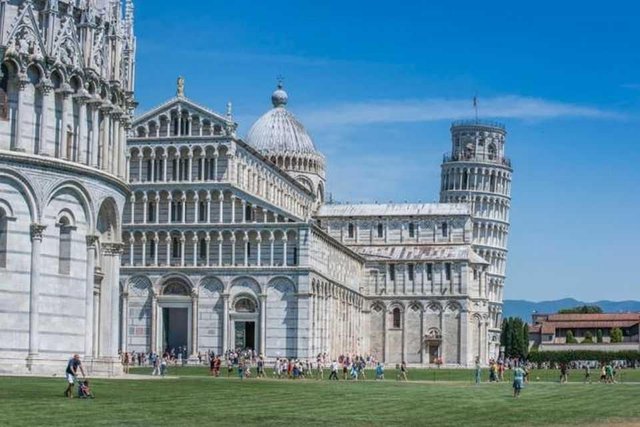The stubborn bell tower from Pisa

In August 1173 in Italy, began to erect the Leaning Tower of Pisa from white marble, as part of the ensemble of Cathedral of Santa Maria Assunta. To the surprise of the builder, five years later incomplete designs began to bend into the ground plane. So it was not reversed at all, the building was frozen for almost a hundred years and only in 1275 the work continued, and the tower reached its present shape in 1372.
By the time the engineers came up with a few tricks, that the appearance was at least according to the architectural sketch. The slightly elongated column on one side straightens the upper floor closer to the vertical axis, and the asymmetric decorative decoration covers the slope. In addition, the builders lowered the design height of the tower, and it was 183 feet on the low side and 186 feet above.
Over the ensuing centuries, the tower stays in an unlimited bow and draws a throng of tourists to a previously unknown city of Italy. The final restoration work includes foundation reinforcement and an 800-ton reciprocity, allowing it to straighten the axial slope of almost one degree. Now the slope angle of the tower is only 4 degrees, and although in many pictures painted in poses that are more awesome than those in reality, this does not prevent people from gathering from all countries to see the strange buildings in private.
Surprisingly, the Leaning Tower of Pisa has stood in this position for nearly 600 years, but the fact that it has survived a series of earthquakes without serious consequences. At least four strong construction shocks have been experienced since the beginning of its construction.
A team of British and Italian engineers and geologists published a study in the journal Earthquake Spectra, which answers the mystery of the survival of the Tower of Pisa with a global catastrophe. Apparently, the main weakness of the design and save it from destruction during the earthquake.
To understand what the problem is, we have to take our eyes deep underground. Under the foundation of 14,500 tons of variable tower Pisa is a layer of sand and clay, compressed evenly. The reason is the base of the burial structure, which in turn causes the slope of the entire structure. Land with variable density for each building - this is a very negative factor, because when the earthquake it increases the shock.
But there is still a dangerous physical phenomenon of resonance when the natural frequency of the building material is equal to the seismic wavelength. In this case, the upper floors begin to oscillate coherently, strong swings, causing a strong lateral force that weakens the underlying beams and columns, and then designs collapse due to its own weight.
In case of seismic waves the Leaning Tower meets on the street of a strictly straight building, and tends, therefore, can not only cause lift. Due to the complex physical interactions they start spinning around the oblique axis and lose most of their energy. Among other things, because selective physical resonance is destroyed during an earthquake. For example, in Japanese cities often notice that falling high-rise houses and skyscrapers and very small structures remain intact.The point is the coincidence of the seismic wavelength and vibration of the object itself, which depends on the stiffness of the building.
That soft soil due to the tilting and instability of the Leaning Tower of Pisa, with its rigidity of buildings and of considerable altitude helped it survive large seismic events. Each tower does not want to get into resonance with the ground during an earthquake.
Reserve forces after the restoration work at the Leaning Tower of Pisa should be enough for at least 300 years, even considering the possibility of an earthquake in Italy.
Good post bro @maywelder